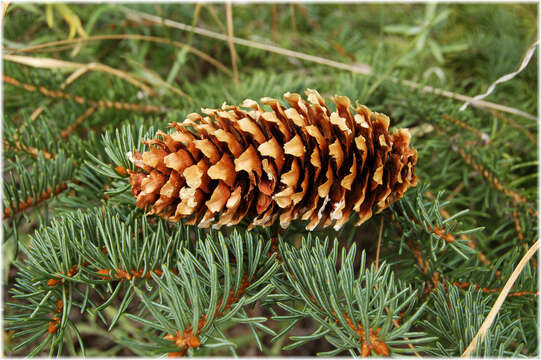Season's Greetings from Engelmann's Spruce

Kuvaus:
Picea engelmannii Parry ex Engelm. var. engelmannii. Lower limbs of an Engelmann Spruce that had caught a fallen cone. Not a posed picture; as it was found. Please consider the tree debris behind and to the side as tinsel! Otherwise I suppose I should have removed it but at the time was just trying to capture exactly how it was.Cones are shorter than Blue Spruce, Picea pungens, and not as papery. This cone bothered me somewhat in terms of being representative of Engelmann's Spruce in terms of its size and bract characteristics. Based on the likely length of the leaves/needles (probably mostly around 2 cm), this cone is easily in the 8 to 10 cm (roughly 4", possibly a little longer) range which is unusually large (cones for this species are usually less than 6 cm, so well less than 3" long. Also the bracts on Engelmann's Spruce cones are often more entire and rounded rather than as above. However, they can also be erose as above, and the shape of the cone above is much more in the expected range compared to the more oblong to cylindric shape of a Blue Spruce cone. The two spruces commonly grow together (although I did not see any P. pungens at this particular spot) and in the same elevational ranges but supposedly do not hybridize.Young twigs have minute hairs whereas those of Blue Spruce are glabrous.Needles not a sharp as Blue Spruce and they tend to be more on the upper side of the twig whereas with Blue Spruce they are spread equally more or less around the twig. September 5, 2011, Wasatch Plateau, Huntington Canyon, Emery County, Utah, approx. 7,185 ft. elev. Most commonly found at 8,000 ft and above however often occurs between 6,500 and 8,000 ft. in Utah.
Mukana seuraavilla sivuilla:
- Life
- Cellular
- Eukaryota (aitotumaiset)
- Archaeplastida
- Chloroplastida
- Streptophyta
- Embryophytes
- Tracheophyta
- Spermatophytes (siemenkasvit)
- Gymnosperms
- Pinopsida
- Pinales (Mäntymäiset)
- Pinaceae (Mäntykasvit)
- Picea (kuuset)
- Picea engelmannii (Engelmanninkuusi)
- Picea engelmannii engelmannii
Tämä kuva ei ole esillä missään kokoelmassa.
Lähdetiedot
- lisenssi
- cc-by-nc-sa
- tekijänoikeus
- Tony Frates
- valokuvaaja
- Tony Frates
- alkuperäinen
- alkuperäinen mediatiedosto
- käy lähteessä
- kumppanisivusto
- Flickr Group
- ID


